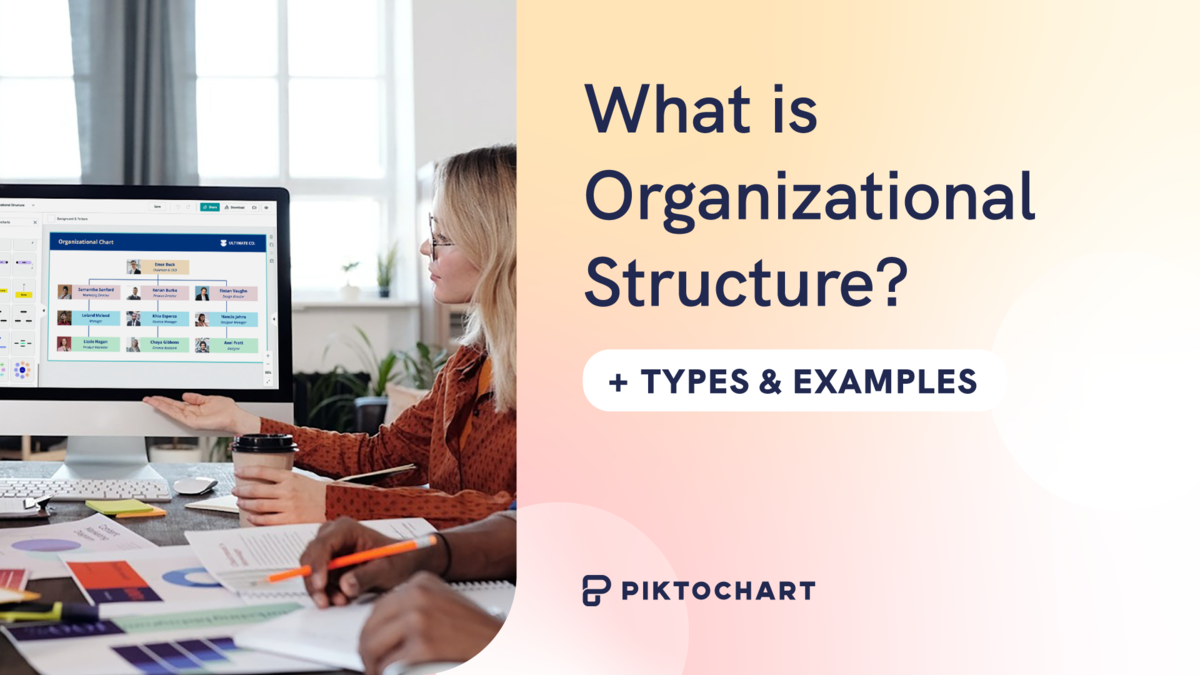An organization’s structure forms the backbone of how work gets done. It provides a framework for making decisions, communicating information, and achieving company goals. But with various organizational structure types to choose from, how do you determine the right one for your business?
This in-depth article explores the world of organizational structures, from traditional hierarchical models to more modern and adaptable designs. We’ll look at the characteristics, benefits, and drawbacks of different structure types and share how to choose and implement the best one based on your company’s unique needs and strategic objectives.
What Is An Organizational Structure?
An organizational structure is a system that outlines how certain activities are directed in order to achieve the goals of an organization. These activities can include rules, roles, and responsibilities. The organizational structure also determines how information flows between levels within the company.
Having a clear organizational structure in place allows companies to remain efficient and focused. It’s one of the most important elements of a successful organization. Without a defined structure, employees may have difficulty knowing their roles and responsibilities, there can be uncertainty about who to report to for what, and decision-making becomes unclear and bogged down.
Investing time to thoughtfully design and communicate the organizational structure pays huge dividends in performance and morale. When done well, an organizational structure provides clarity, enables better decision-making, and stimulates collaboration between different parts of the organization.
4 Common Types of Organizational Structures
1. Functional Organizational Structure
The functional structure organizes employees based on their specific skills and puts them in departments based on their specializations, such as marketing, sales, engineering, or human resources. Small-to-midsize companies often use a functional structure since they can group skills and avoid duplication of effort.
Some of the key advantages of a functional structure are:
- Allows team members to specialize and focus on their core competencies
- Provides opportunities for professional development and career pathing within the function
- Single reporting lines and clear chains of command facilitate oversight and decision-making
However, potential disadvantages include:
- Can lead to “siloed” thinking where functions are isolated and lack understanding of other areas
- Weak coordination between different departments which can slow down execution
- High degree of interdependence between functions which can cause bottlenecks and single points of failure
Here is an example functional org chart showing a typical hierarchical breakdown:
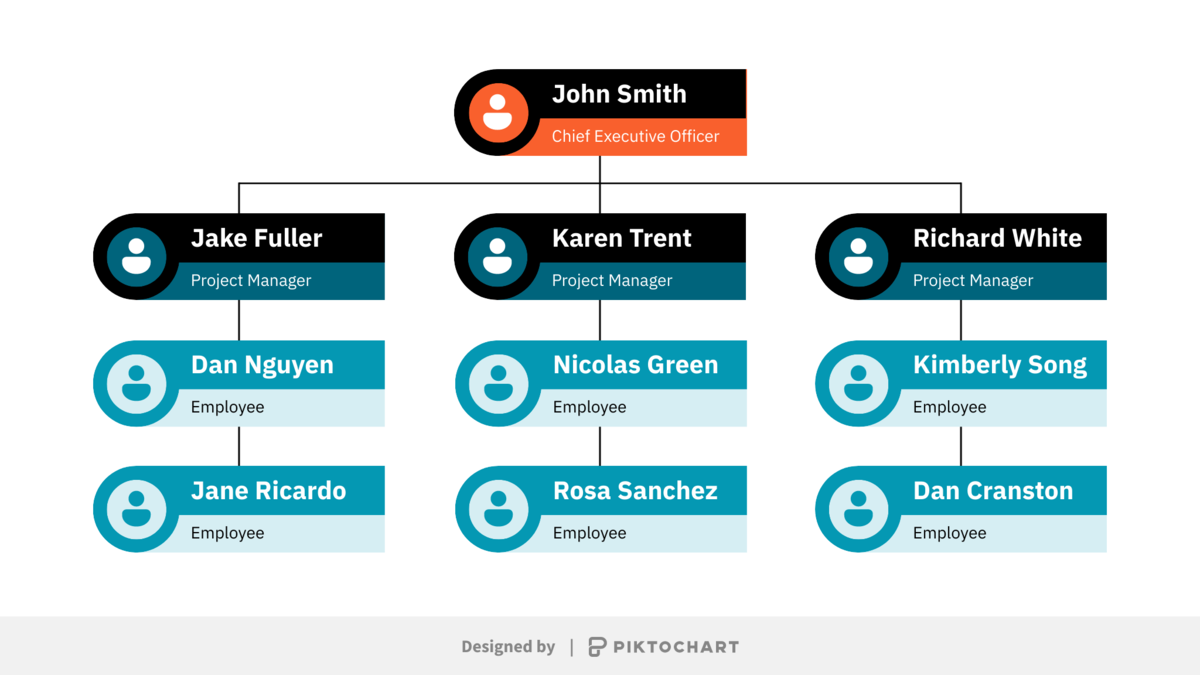
2. Divisional Organizational Structure
A divisional structure organizes the company according to individual products, projects, or geographies. For large companies with multiple business units offering different products or serving different markets, the divisional structure empowers each unit to operate autonomously and address the unique needs of its product or market.
For example, a consumer goods company might organize its divisions by product category: Cleaning Products, Paper Products, Personal Care, Food & Beverage, etc. Each division contains its own functional sub-departments such as product development, marketing, sales, and distribution.
The divisional structure is well-suited for organizations serving diverse markets or customer segments because it allows for a customized approach while still enabling economies of scale. Some key advantages are:
- Allows each division to focus on its product and react quickly to market changes
- Enables divisions to develop deep expertise about their customers and market segments
- Provides clear profit and loss accountability and insight into each division’s performance
Potential drawbacks of the divisional approach include:
- Duplication of functions and resources across divisions
- Lack of coordination and knowledge sharing between divisions
- Loss of efficiencies from decentralized decision-making and lack of standardized processes
Here is an example of what a divisional organizational structure might look like:
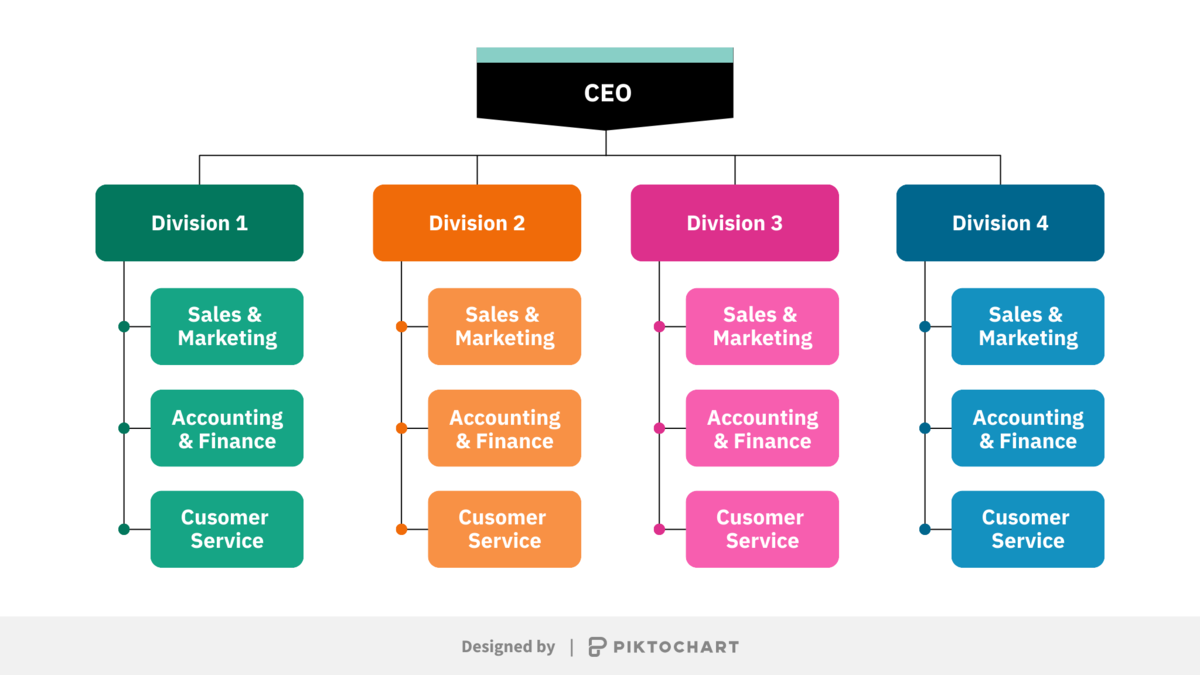
3. Matrix Organizational Structure
A matrix structure is a hybrid of the functional and divisional structures. Employees are grouped by function and product in a matrix configuration. This structure can be used when there are multiple products or projects that require inputs from various functional areas.
For example, a software company might have functional departments such as Product Management, Software Development, Quality Assurance, Technical Operations, etc. But each individual product the company produces would also have dedicated teams with representatives from the different functional specialties.
In a matrix, there are typically two management chains – a functional manager and a product or project manager. Employees report to both managers simultaneously for different aspects of their work.
Some advantages of the matrix structure are:
- Efficient use of resources since functional experts are shared across products/projects
- Enables employees to develop both functional and product/project skills
- Flexibility to put together teams based on changing product/project needs and priorities
Disadvantages can include:
- Dual reporting relationships which can be confusing and lead to conflict between managers
- Decision-making can take longer in a matrix due to the need for more consensus
- Employees may feel torn between competing priorities from their functional vs. product managers
An example matrix organizational chart might look something like this:
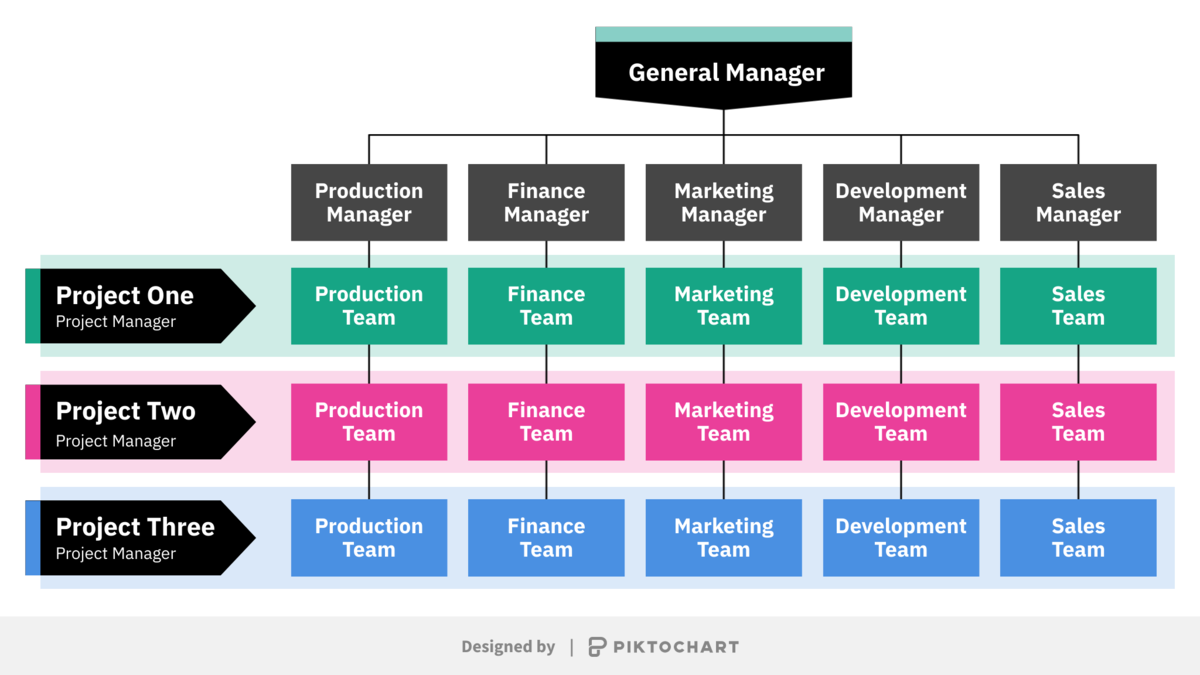
4. Flat Organizational Structure
While the previous three types of org structures are more traditional hierarchical forms, the flat organizational structure aims to place all employees on the same level. Sometimes called a “self-managed” organization, the flat structure aims to decentralize decision-making and give employees more autonomy.
In a flat organization, there are typically few or no levels of middle management between employees and executives. The span of control is wide with more direct reports per manager. Communication is often more frequent and less formal. And employees are empowered to take on higher level responsibilities and decision-making.
Some companies that have adopted a flat structure include Zappos, Medium, and Buffer. It tends to work best for smaller companies, startups, and those in more creative, fast-moving industries.
Benefits of a flat structure can include:
- Faster communication and decision-making due to lack of bureaucracy
- Employees feel more engaged and motivated by the autonomy and responsibility
- Fosters innovation and creativity by empowering all employees to contribute ideas
Some of the risks are:
- Confusion and lack of coordination if decision-making isn’t well-defined
- Managers can become overwhelmed if span of control is too broad
- Lack of formal career paths and promotion opportunities for employees
A flat org chart has minimal levels and might look like this:
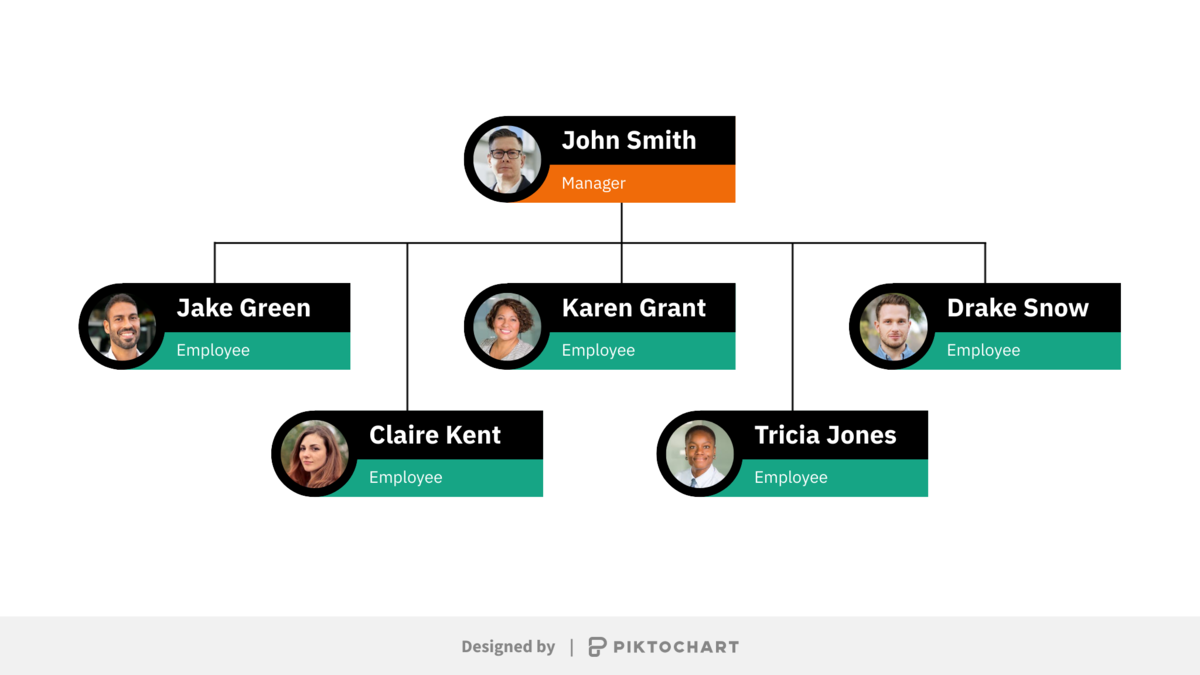
While those are four of the most common organizational structures, there are other models some companies adopt such as circular, network, or team-based structures. The choice depends on many factors including company size, industry, strategy and leadership philosophy.
Other Types of Organizational Structures
Beyond the four main types covered above, there are a few other organizational structure types that are less common but can be a fit for some organizations.
Team-Based Organizational Structure
A team-based structure is similar to the matrix structure except employees are organized into teams by project or product rather than belonging to distinct functional departments. The teams are self-directed and cross-functional.
This model works well for companies with fast-moving projects that require diverse skill sets and a high degree of collaboration. The videogame industry is known for using a team-based model.
Network Organizational Structure
A network structure relies heavily on third parties and outsourcing to accomplish its goals. There is a small central hub that coordinates the activities of external teams or individual contractors.
This structure affords a high degree of flexibility and keeps the organization lean. But it also requires strong communication, coordination and an ability to integrate the work of disparate parties.
Projectized Organizational Structure
In a projectized structure, teams are formed specifically for the duration of a project and then disbanded. This is common in industries like management consulting or IT services where client-based project work is the core business model.
Employees don’t belong to permanent functional departments, but rather are assigned to different projects based on their skills and the project’s needs.
When determining the right organizational structure for your company, it’s important to analyze the key factors that will shape which model works best. Let’s look at how to assess the best structure fit.
Factors to Consider When Choosing an Organizational Structure
Selecting the optimal organizational structure for your company is a critical strategic decision. The structure you adopt will impact how work gets done, how quickly you can pivot and adapt, and how easily you can enable collaboration across teams.
There are five key factors to weigh when deciding on the best-fit structure:
1. Company size and stage
Startups and small companies often adopt a flatter structure early on when speed and flexibility are paramount. As an organization grows, however, some hierarchy will be necessary to ensure proper governance and decision-making. That’s when more traditional structures like functional or divisional models may be adopted.
2. Industry and business model
Certain industries lend themselves to different structures. Manufacturing companies often use a divisional structure aligned to product lines. Consulting and professional services gravitate toward a projectized model. Retail and hospitality companies tend to prefer a functional structure.
3. Strategy and objectives
Your organizational structure should support and align with the company’s strategy and objectives. If international expansion is a priority, a geographical divisional structure may be optimal. If product innovation is the focus, a matrix or team-based model can work well.
4. Need for collaboration vs. efficiency
Certain structures like the matrix and team-based models facilitate high levels of cross-functional collaboration which is important for developing complex products or solutions. But they can also slow down decision making.
Functional structures promote efficiency and functional excellence, but can lead to silos. The ideal structure balances the organization’s needs for collaboration and efficiency.
5. Culture and leadership philosophy
The prevailing culture and leadership philosophy will also influence the choice of structure. If the culture values autonomy and agility, then a flatter, more decentralized structure would be fitting. A more top-down, hierarchical culture would align with the traditional functional model.
Considering these criteria carefully can help narrow down the selection to the structure that will best support the organization’s goals. Of course, structures can also evolve as the company grows and strategies shift. Many organizations may use a hybrid of different models tailored to their needs.
Once you’ve decided on an organizational structure, the next step is to implement it effectively. Organizational design is a major undertaking, so it helps to follow proven best practices.
5 Tips for Implementing an Organizational Structure
Implementing a new organizational structure is a significant change that requires thorough planning and consistent communication. Here are five tips critical to organizational success:
1. Clarify roles and responsibilities
Organizational structures define how work gets done and who has the decision-making authority. As you roll out a new structure, documenting and communicating roles, responsibilities, decision rights, and measures of success for each position is vital so everyone understands expectations.
2. Align the structure to the strategy
Implementing a new org structure because it’s a shiny new trend is never a good idea. There should be a clear link between the new structure and the company’s overall strategy. Communicate that link consistently to employees. A structure change should feel connected to a larger purpose and direction.
3. Design with the future in mind
While you should base the structure on current business priorities, also consider where the organization is headed. Are international markets a focus in the next few years? Will new products and services be launched? Factor future plans into the design so you won’t have to restructure again too soon. Building in some flexibility is wise.
4. Gather employee input
Engaging employees in the organizational design process promotes buy-in and allows you to tap into their frontline insights. Use focus groups, surveys and interviews to solicit employee perspectives. Incorporate their views into the design and decision-making process as much as possible.
5. Communicate consistently
Use a multichannel approach to communicate the details of the new structure to employees. Share the strategic rationale, timeline, roles and expectations. Provide FAQs, forums for employees to ask questions, and resources to help them navigate the change.
Consistent communication, especially from leaders and managers, is essential to build understanding and support for the new structure. Ensure two-way communication and feedback mechanisms.
Following these best practices can smooth the transition to a new organizational structure. But even with great change management, questions will inevitably arise. Let’s address some of the most common ones.
Final thoughts
Organizational structures are never perfect or permanent. Even the most carefully designed structure will need to flex as strategies and priorities change. The goal is to find the model that best positions the company for success while enabling employees to work productively and collaboratively.
Navigating an organizational restructure can be challenging, but with solid change management practices, the process is doable. It’s usually easier to implement when there’s a visual representation of the proposed structure. If your company is considering an organizational redesign, using a tool like Piktochart to map out options and create polished visualizations can take the headache away from designing. You can leverage one of our templates, or use Piktochart AI to quickly design something for you. Try it for yourself today and sign up for free.
FAQs
What is the most common type of organizational structure?
The functional structure is the most common type. It organizes employees by their specific skills and groups them with others who have related skills. The functional structure is typical of mid-sized companies that have a variety of products and services that need a high degree of specialization.
How does company size affect organizational structure?
Company size is one of the biggest factors influencing the choice of structure. Small companies often use a flat structure with little hierarchy. Employees take on broad roles. As companies grow, they tend to become more hierarchical and siloed. They require a more extensive structure to run efficiently and provide adequate management and guidance. Larger enterprises are more likely to adopt a divisional or matrix structure.
Can a company have multiple organizational structures?
Yes, companies can operate multiple organizational structures simultaneously. For example, a large company might have a divisional structure based on product lines, but within each division, they may use a matrix to manage specific projects. There may also be some standalone functional departments that serve all divisions such as Finance and HR. Many large companies use a hybrid of different models in this way.
How often should a company change its organizational structure?
How often a company changes its structure depends on a variety of factors such as shifts in strategy, entry into new markets, mergers/acquisitions, and leadership changes. In general, structure changes are disruptive and should not be done frequently. A good rule of thumb is to review the structure when strategic plans are updated, usually every 3-5 years. However, fast-growing companies may need to adapt more often. The key is to strive for a structure that balances necessary change with organizational stability.
The right organizational structure will look different for every company. What works for a global enterprise won’t fit a small startup. The optimal structure aligns with strategy, but it also must support effective execution and company performance.
